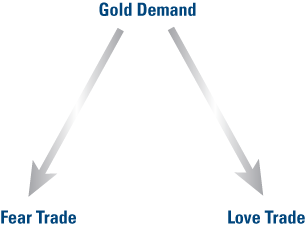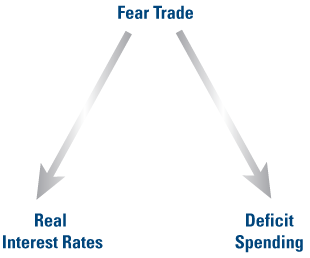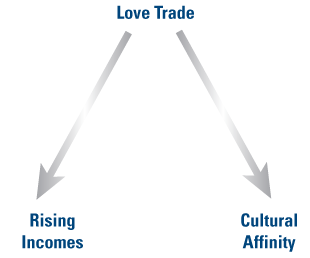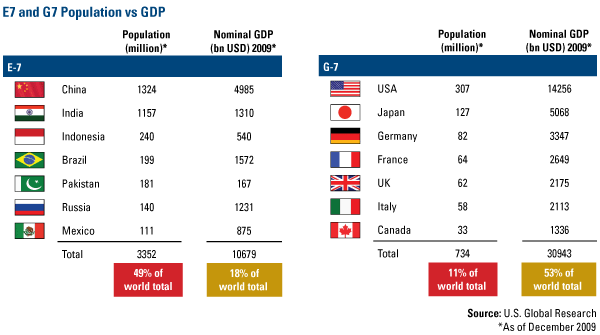Wall Street has been calling gold a bubble since 2005 when it hit $500. Some media naysayers remained negative even as they wrote the headlines proclaiming record highs and saw gold rise almost 30 percent in the past 12 months.
Interestingly, despite gold’s latest run, it was still a laggard compared to many other commodities. In the commodity world, gold didn’t even place in the top half in 2010. Against a basket of 14 commodities that includes everything from aluminum to wheat, gold’s 29.52 percent return places it eighth. Palladium took the top spot with a 96.6 percent return, followed by silver with an 83.21 percent return. Natural gas continued its cellar-dwelling ways, dropping 21.28 percent to become the worst-performing commodity of the basket.
There are two main drivers of gold demand: The Fear Trade and the Love Trade.
Fear Trade: The fear trade is what you often hear about from the media and the gloom-and-doomers. The fear trade is driven by negative real interest rates—where inflation is greater than the nominal interest rate—and deficit spending. Whenever you have negative real interest rates coupled with increased deficit spending, gold tends to rise in that country’s currency.
In the U.S., we’re in the middle of an extended period of negative real interest rates that will likely last through the year. The Federal Reserve is acutely aware that if interest rates should spike, it would be catastrophic for the economic recovery.
Looking back over the past 400 years, there has been a major currency or credit crisis every decade and, historically, it takes approximately four years to heal from the contraction. The U.S. economy is on the road to recovery, however the elevated number of home foreclosures and high unemployment make it unlikely the Fed will risk a relapse by raising interest rates any time soon. The government is also unlikely to cut spending or welfare support during the healing process.
As for deficit spending, we still have an oversized government, creating regulatory traffic jams for business development and hurdles for economic trade.
Love Trade: The love trade is significant and unique to gold. People buy gold out of love and those in emerging markets are especially amorous of the metal. We refer to the most populous seven of the emerging economies as the E-7. Currently, the E-7 countries hold nearly half of the world’s population but make up less than 20 percent of global GDP. The G-7 industrialized nations are a mirror of this; they host 11 percent of the world’s population but control more than 50 percent of the global economy.
But things are changing.
I’ve discussed this many times but it’s important to grasp how today’s world looks a lot different than yesterday’s. Many of these emerging economies are averaging over 6 percent GDP growth and personal incomes are rising around 8 percent. In addition, emerging economies are home to 27 percent of the world’s purchasing power, according to economic research firm ISI.
It is customary in most emerging countries to give gold as a gift to friends and relatives for birthdays, weddings, and to celebrate religious holidays.
In December, the Shanghai Gold Exchange reported that China imported five times more gold in 2010 than 2009 and that was just during the first 10 months of the year. In India, spending on gold rose 100 percent on a year-over-year basis through September, according to Morgan Stanley. Russia’s central bank holdings of gold rose 7 percent in 2010.
What is important to remember when looking at the history of gold is that in the 1970s, China, India and Russia were isolationists with no significant global economic footprint. The world’s population was 3 billion and today we have witnessed an awakening of epic proportions.
These countries are growing with free market policies and massive infrastructure spending. In the 1970s, gold rose on the fear trade and the cold war. Today the world is significantly different and the love trade drives gold.
If QE2 was the fuel that sent gold prices to the moon, the gold holiday season was the vehicle they rode in. Gold prices rose steadily as Ramadan came early, which then carried into the Diwali season of lights in India. Then came Christmas, with shoppers around the world spending more than they had in years.
Next is the Chinese New Year—the Year of the Rabbit—on February 3. It’s believed that people born in the Year of the Rabbit are wise, financially lucky and have a gift for making the right decision—similar to how gold investors are feeling these days.
Looking Ahead
It’s impossible to predict where gold prices will be 12 months from now but we think gold prices could double over the next five years. This would mean roughly a 15 percent return, if you compounded it annually.
However, it will by no means be a straight line. Volatility is always inherent in commodity investing. It’s a non-event for gold to go up or down 15 percent in a year—this happens 68 percent of the time. For gold stocks, the volatility is even more dramatic—plus or minus 40 percent, historically.
We have always suggested that investors consider a 10 percent weight in gold funds and rebalance their portfolio each year to capture the volatility and not chase return. Since gold was up almost 30 percent last year, it could easily correct from its peak by 10 to 15 percent. This is why we believe gold stock investors need to be active, not passive, when it comes to managing portfolios.
Investors looking to either add to or initiate new positions in gold must be aware of this volatility and use it their advantage. Use sharp selloffs as cheap entry points and make sure to rebalance those portfolios in order to lock in profits from 2010’s big gains.
For more updates on global investing from Frank and the rest of the U.S. Global Investors team, follow us on Twitter at www.twitter.com/USFunds or like us on Facebook at www.facebook.com/USFunds. You can also watch exclusive videos on what our research overseas has turned up on our YouTube channel at www.youtube.com/USFunds.
Gold, precious metals, and precious minerals funds may be susceptible to adverse economic, political or regulatory developments due to concentrating in a single theme. The prices of gold, precious metals, and precious minerals are subject to substantial price fluctuations over short periods of time and may be affected by unpredicted international monetary and political policies. We suggest investing no more than 5% to 10% of your portfolio in these sectors.
All opinions expressed and data provided are subject to change without notice. Some of these opinions may not be appropriate to every investor. Diversification does not protect an investor from market risks and does not assure a profit.











